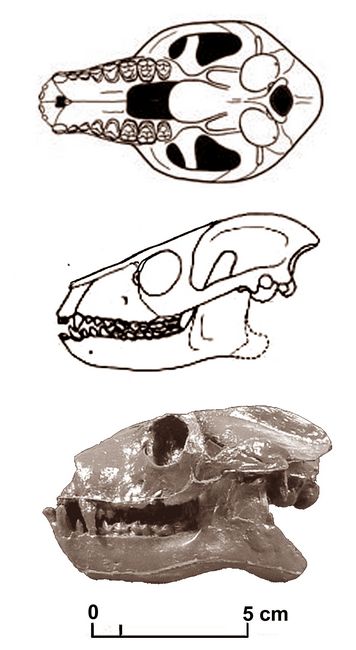Athena Review Image Archive ™
Notharctus tenebrosus skull and dentition

Skull and dentition of Notharctus tenebrosus
Notharctus tenebrosus
was an early, adapiform, tree-dwelling primate from the Eocene period,
dating from 54-38 mya. Adapids are considered to have been lemur-like,
as contrasted with tarsier-like omomyids, another group of early
primates. Notharctine primates are abundant in early (Wasatchian) and
middle (Bridgerian) Eocene faunal assemblages from western North
America. Early Eocene adapidae forms are dominated by Cantius, which was replaced in the middle Eocene by Notharctus and Smilodectes, both found most commonly in southwestern Wyoming.
First described by Leidy (1870), Notharctus tenebrosus, about
40 cm in length, is considered one of the earliest known primates
in the lineage of
humans.
The skull of Notharctus
had a complete postorbital ring and a cranial crest. Both eyes were
directed forwards for binocular vision. The eyes were smaller than
those of omomyids such as Tetonius
and were higher on the skull. The jawbones fused at the chin, creating
a single solid mandible. The incisors and canines were smaller than
those of some other early primates such as Vulpavus.
References:
Gregory W.K. 1920. On the structure and relations of Notharctus, an American Eocene primate. Memoirs of the American Museum of Natural History.
Gunnell,
G. 2002. Notharctine primates (Adapiformes) from the early to middle
Eocene (Wasatchian–Bridgerian) of Wyoming: transitional species and the
origins of Notharctus and Smilodectes.
Leidy, J. 1870. Descriptions of Palaeosyops paludosus, Microsus cupidatus and Notharctus tenebrosus. Proceedings of the Academy of Natural Sciences, Philadelphia 22:111-114.
Copyright © 1996-2020 Rust Family Foundation (All Rights Reserved).